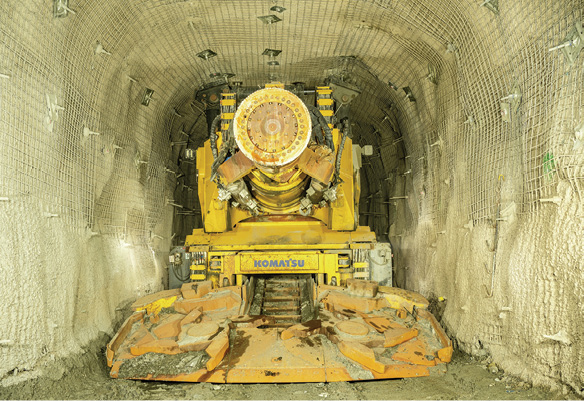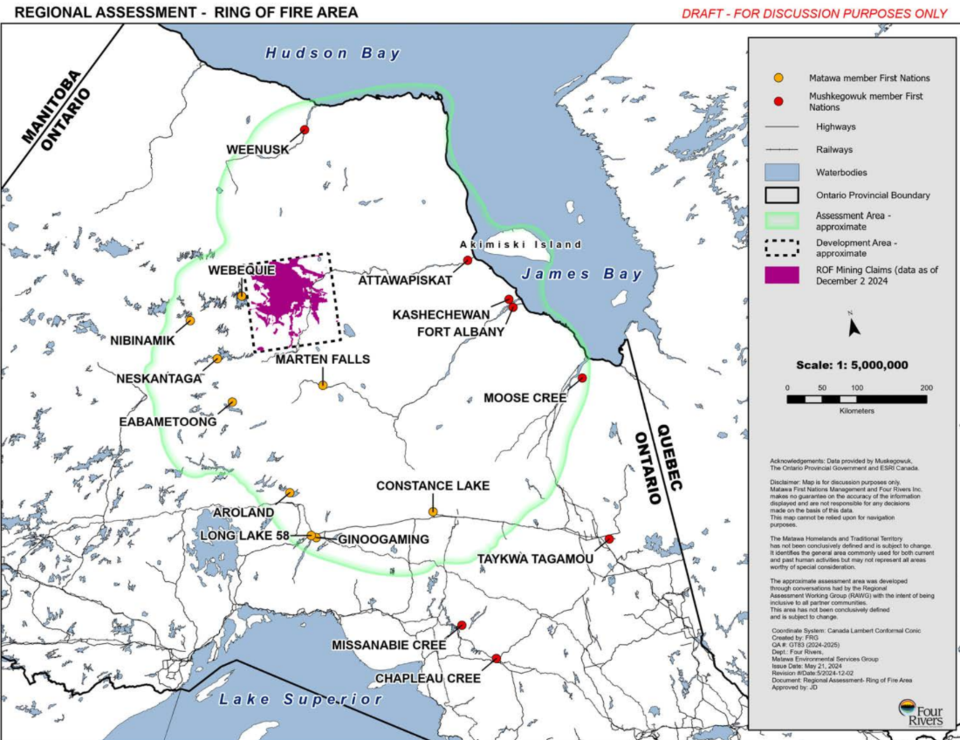Komatsu’s MC51 ready to rock at Garson

Hard rock continuous miner undergoing 1-year trial at Vale mine in Sudbury
If you made it to this year’s MINExpo convention in Las Vegas, you might have witnessed Komatsu’s MC51 hard rock continuous miner in action – kind of.
While the machine wasn’t actually at the show, there was a life-size video display of the MC51 doing what it is designed to do – mechanically chewing through rock (simulated in this case) using a cutter mounted on a robotic boom. The cutter’s smooth and quick movements as it chipped the rock into small pieces to excavate a 5- by 5-metre tunnel were hypnotizing.
“The stand was never empty – there were always people there talking about mechanical cutting and about the future of that technology,” says Stephen Styles, Komatsu product manager, hard rock mining.
Considering the departure that continuous hard rock mining represents from conventional mining, it’s not a surprise that the display attracted such interest.
The mining sector has long sought a workable alternative to the status quo drill-blast-muck-haul cycle of underground mining, for efficiency, productivity and safety reasons.
Existing tunnelling machines used for civil applications don’t have the flexibility, agility or smaller size needed for mining applications, and the pick-based rotary style of cutting that works for soft rock continuous mining machines used for coal and potash isn’t effective for hard rock applications.
There are some hard rock continuous cutters available, but none have been widely adopted or commercialized yet.

The MC51, Komatsu’s entry into the space, is the result of more than 10 years of development. The machine’s key competitive features include its low energy requirements – thanks to its DynaCut technology – and its mobility and agility for the underground environment (it’s about 12 metres long).
And after completing successful initial tests of its prototype MC51 machine last year at Newcrest Mining’s Cadia gold mine in Australia, Komatsu has begun a larger trial in partnership with Vale at its Garson mine in Sudbury.
Vale partnership
The trial started in October, after the Komatsu MC51 had been shipped to site, reassembled and transported about 2.5 km underground.
During the Cadia trial, the machine advanced 50 metres in rock with about 180 MPa hardness, says Stephen Styles, product manager for the MC51. (That machine is still in Australia and now slated to develop a portal and decline for a copper operation owned by Hillgrove Resources.)
“That was more of a process-oriented, engineering-specific trial” to test the fundamentals of the machine’s performance, says Styles of the Cadia trial.
The new trial, lasting nine to twelve months, will be more ambitious, aiming to advance 400 metres and testing the machine’s capabilities in the harder rock of the Canadian Shield.
“We want to validate that we can advance anywhere between 3 and 4 metres per shift in extremely hard rock. We’re in the Canadian Shield here and that’s globally known for its rock properties of being quite hard,” says Styles, adding that 3 to 4 metres per shift would be competitive with drill and blast advance rates in this part of Canada.
In addition to testing the MC51 in harder rock (200 to 250 MPa), Garson was chosen for its ramp access, making the logistics of getting the machine in place easier.
The partnership with Vale is aimed at accelerating testing and commercialization of the machine – for Vale and other miners to use – as well as proving that the technology works and meets high safety standards.
In a joint presentation at MINExpo between Komatsu and Vale, Vale Base Metals’ principal mining engineer Andy Charsley noted that the trial would be the largest mechanical rock cutter trial ever undertaken.
“Our intent is to test the ability of the technology to not only cut the very hard rock of the Canadian Shield, but to challenge the technology to cut at a commercial rate that will compete with traditional drill and blast development,” he said. “Vale plans to demonstrate the ability to cut rock at a commercial rate, quantify the cost per metre of operation, and look at the comparison with conventional drill and blast development. At the same time, we will assess the health and safety and environmental suitability of the mechanical rock excavation process and gain insight into the potential of an optimized mechanical rock excavation process for the future.”
Charsley also noted that the ability of the cutter to integrate with existing infrastructure and equipment within the current process at the mine (bolters, trucks and scoops) is key to implementing the technology.
While the machine will be used for development of drifts rather than production, Styles says the trial will bring the MC51 into ore, so it should also provide information on how it performs in ore as well as waste rock.
DynaCut technology
The MC51 has a cutter on a single, 5-axis robotic boom that can profile any shape within a 5 metre by 5 metre profile – the most common size of development tunnel. It is highly precise and accurate (it can cut to within 50 mm of plan), resulting in high tunnel quality and the reduction of over break.
After the MC51 cuts the rock into small, consistently sized chunks, it gathers the material to the centre of the machine, where it is conveyed to a mine truck or LHD behind it to be hauled away.
The machine, which sits on a set of Komatsu tracks, is quite mobile, and is also able to stabilize itself during the cutting process.
The tethered electric machine is also able to cut rock with a very low power requirement thanks to Komatsu’s DynaCut technology.
Styles explains that the cutter attacks the rock in an undercutting fashion to exploit the weaker tensile strength of the rock. Dynamically undercutting the rock with the right balance of force and excitation allows the machine to be small and agile and use less energy.
Styles notes that DynaCut is different than the oscillating disc cutting (ODC) technology Komatsu predecessor company Joy Global licenced from Mining3 in the mid-2000s. After testing the technology at platinum mines in South Africa, the company felt it was not yet commercially viable and there was an opportunity to improve reliability and advance rates.
However, the company did use what it learned from implementing the ODC technology to develop the DynaCut technology over the last five to six years.
Additional features of the MC51 include automation of the cutting process, allowing the machine to be operated via remote control (for now, line of sight), and taking the operator away from the cutting face.
(Styles says a jumbo operator could easily be trained to operate the MC51.)
The controlled cut and high degree of accuracy and tunnel quality the MC51 offers could also reduce the amount of ground support required or the time it takes to install it.
“We think we should get some advantages with mechanical cutting compared to drill and blast in terms of the quality of the tunnel as it’s developed,” Styles says. “It will be more precise so we’d like to think the ground support could be done quicker.”
Komatsu says its aim with continuous hard rock miners is not to replace drill and blast in underground mining, but to complement it.
“It gives our customers another option,” Styles notes. “Some of the things we like to consider is with mechanical cutting you’ve got a continuous operation, so there are fewer steps, there’s less equipment required, you’ve got less emissions because it’s an electric machine. You’ve got (improved) tunnel quality and you’ve got automation.”
Since it replaces the previously separate drill and blast steps, the machine also reduces the amount of equipment and personnel needed, as well as improving safety. That revolutionary potential isn’t lost on anyone.
“We are trialling this new machine and technology because it offers the potential to really change the way we mine.” said Luke Mahony, head of technology and innovation, Vale Base Metals in a video presentation at MINExpo.
Komatsu and Vale expect to provide regular updates on the results of the trial. In the meantime, to watch a demonstration of the MC51, visit www.komatsuevents.com.





Comments